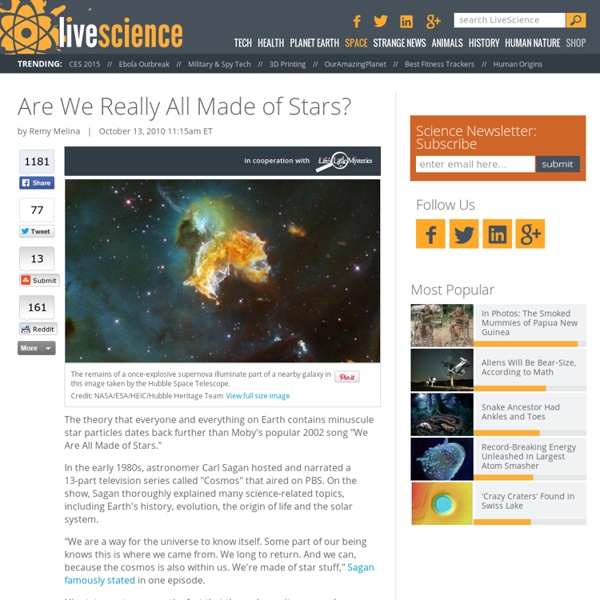How Old is the Milky Way ?
eso0425 — Science Release VLT Observations of Beryllium in Two Old Stars Clock the Beginnings 17 August 2004 Observations by an international team of astronomers [1] with the UVES spectrometer on ESO's Very Large Telescope at the Paranal Observatory (Chile) have thrown new light on the earliest epoch of the Milky Way galaxy. The age of the Milky Way How old is the Milky Way? Globular clusters and the ages of stars Modern astrophysics is capable of measuring the ages of certain stars, that is the time elapsed since they were formed by condensation in huge interstellar clouds of gas and dust. Stars belonging to a globular cluster were born together, from the same cloud and at the same time. Still, those cluster stars were not the first stars to be formed in the Milky Way. Despite intensive searches, it has until now not been possible to find less massive stars of this first generation that might still be shining today. Beryllium to the rescue Galactic cosmic rays and the Beryllium clock Notes
Matter
Before the 20th century, the term matter included ordinary matter composed of atoms and excluded other energy phenomena such as light or sound. This concept of matter may be generalized from atoms to include any objects having mass even when at rest, but this is ill-defined because an object's mass can arise from its (possibly massless) constituents' motion and interaction energies. Thus, matter does not have a universal definition, nor is it a fundamental concept in physics today. Matter is also used loosely as a general term for the substance that makes up all observable physical objects.[1][2] All the objects from everyday life that we can bump into, touch or squeeze are composed of atoms. Matter should not be confused with mass, as the two are not quite the same in modern physics.[7] For example, mass is a conserved quantity, which means that its value is unchanging through time, within closed systems. Definition Common definition Relativity Atoms definition Structure Quarks
Science & Environment - Drake equation: How many alien civilizations exist?
Are we alone? It is a question that has occupied mankind for centuries. Today, we live in an age of exploration, where robots on Mars and planet-hunting telescopes are beginning to allow us to edge closer to an answer. While we wait to establish contact, one technique we can use back on Earth is an equation that American astronomer Frank Drake formulated in the 1960s to calculate the number of detectable extraterrestrial civilizations may exist in the Milky Way galaxy. It is not a rigorous equation, offering a wide range of possible answers. Until ground-based observations, space telescopes and planet-roving robots uncover any tell-tale signs of life, what better way to speculate on how many intelligent alien civilizations may exist than to explore the universe with our interactive version of the equation.
What Is Caustic Soda and Where Can You Get It?
Key Takeaways: Caustic Soda Caustic soda is one of the common names for sodium hydroxide (NaOH).It is also known as lye, although lye may refer to either potassium hydroxide or sodium hydroxide.Pure caustic soda is sold for making candles or soap.Impure caustic soda is found in drain cleaner.Because lye is used to make illegal drugs, it's harder to buy large quantities than in the past. However, small containers are available in stores and online. Uses of Caustic Soda or Lye Lye is used for soap making, candle making, homemade biodiesel, frosting glass, making several foods, and for chemistry experiments. How To Get Caustic Soda or Lye It's much harder to get hold of lye than it used to be in the past. drain cleaner (check the label) - e.g., Roebic Crystal Drain Cleaner, sold as Lowessodium hydroxide from an online chemical supply storesoap making storecandle making storebiodiesel supply store Helpful Tips Since it's relatively hard to get hold of this chemical, you may need to buy in bulk.
Mulungu Bark and Mulungu Powder
Mulungu Mulungu is a medium-sized, well-branched tree that grows 10-14 m high. It produces many pretty, reddish-orange flowers (pollinated by hummingbirds) at the ends of the tree's many branches. The tree is sometimes called "coral flower," as the flowers resemble the color of orange coral. Several Erythrina tree species are used by indigenous peoples in the Amazon as medicines, insecticides, and fish poisons. Mulungu has long been used in by indigenous peoples as a natural sedative: it has been used to calm an overexcited nervous system and promote a restful sleep. In both North and South American herbal medicine, Mulungu is considered to be an excellent sedative to calm agitation and nervous coughs and to treat other nervous system problems including insomnia and anxiety. Mulungu is not very widely known or used in North America; mostly appearing as an ingredient in only a few herbal formulas for anxiety or depression.
Composition of the human body
The main elements that compose the human body are shown from most abundant (by mass) to least abundant. The elemental composition of the human body can be looked at from the point of view of either mass composition, or atomic composition. To illustrate both views, the adult male human body is approximately 57% water, and water is 11% hydrogen by mass but 67% by count of atoms (i.e. 67 atomic percent). Thus, most of the mass of the human body is oxygen, but most of the atoms in the human body are hydrogen atoms. Body composition may also be analyzed in terms of molecular type (e.g., water, protein, connective tissue, fats (or lipids) apatite (in bones), carbohydrates (such as glycogen and glucose) and DNA. Major, minor and trace elements[edit] Pie charts of typical human body composition by percent of mass, and by percent of atomic composition (atomic percent). Almost 99% of the mass of the human body is made up of six elements: oxygen, carbon, hydrogen, nitrogen, calcium, and phosphorus.



